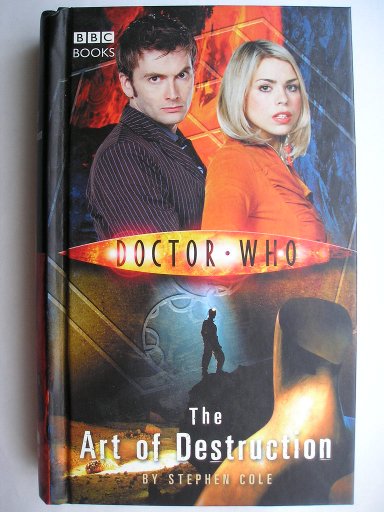
The novel “The Art of Destruction” by Stephen Cole was published for the first time in 2006.
The TARDIS brings the Tenth Doctor and Rose Tyler to Chad in 2118, near a volcano. There, a agricultural team that is a bit pecualiar is trying to develop a fungus that can grow in the dark caves of the area feeding off anything that can be found there and at the same time has a high nutritional value.
The Doctor has detected alien signals in the area, where apparently only human activities are in place. Things change when one of the agriculture team members is infected with a substance that turns him into a kind of golem. The events become more and more chaotic and the Doctor must figure out what’s behind it before the danger extends well beyond the area.
“The Art of Destruction” is part of a series of novels connected to the new “Doctor Who” series. They’re targeted to a wide audience by being linear enough to be appreciated even by very young readers but sophisticated enough to interest more mature readers.
“The Art of Destruction” is set in Africa in the 22nd century, where the problems are in many ways the same as today. Despite the technological advancements, in many areas of the continent there are still political and social chaos and a lot of people are suffering from hunger. A group of farmers is growing genetically modified fungi so that they’re nutritious enough to be a good meal for the people. Their work, already quite complex due to the local situation, is put in jeopardy when they come across an alien presence that seems decidedly hostile.
When the Doctor and Rose, attracted by an alien signal coming from that area, reach the volcano, they discover that one of the farmers has been transformed into a kind of golem. It’s just the beginning of an adventure where travelers and farmers face increasing dangers and solving the mystery of the alien activity isn’t enough.
The pace of “The Art of Destruction” is really fast, not only for the limited length of the novel but also because Stephen Cole put in it many elements that make the plot complex. In fact, the story puts together alien dangers with others of local origin.
Especially in the first part of the novel, the information on the political and social situation of the area and the background about the farmes allow Stephen Cole to put in it themes that you could see in the adventures of the classic “Doctor Who” series written by Malcolm Hulke, an author who put that kind of elements in his stories. In this case, however, there was no space to really develop them.
The readers can see that the problems in certain areas of Africa are essentially the same as today. Life is difficult for the natives and a group of rebels, who claim to want to help common people, actually makes things worse. In the course of the novel, they also threaten the farmers but get much more than they bargained for.
In the end, the problem of the alien threat remains central in the novel. The story of the Doctor’s attempt to understand what’s behind that and to save the farmers becomes more and more complex with twists all the time. The many characters end up being sacrificed because the limits of the format of these books don’t allow Stephen Cole to develop them properly. It’s indeed a plot-oriented novel where the plot development takes up all the space.
The very fast pace and the twists can hide the flaws, at least before you have finished reading it and can think about it. In the last part of the novel, the tone that was generally dramatic becomes at times too lighthearted, over the top in a way that’s almost farcical. This is primarily due to certain aliens that make the Slitheen look sophisticated.
Overall, “The Art of Destruction” is a rather heterogeneous mixture of elements that can be more or less interesting but all in all enjoyable. I think it’s particularly suitable for readers who love action stories and weird aliens.


Permalink
I thought this review was nice and liked your views on the book.